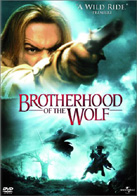Brotherhood of the Wolf (Le pacte des loupes)
| It is 1694, and there is trouble in the French countryside. A large beast—some claim it is a giant wolf, others swear it is a demon, but no one is really sure—has been attacking women and children in the southern province of Gévaudan. Hunters and soldiers have been unable to track it and kill it, and word is starting to leak to Paris about the problem. So begins The Brotherhood of the Wolf (Le pacte des loups), a hyperkinetic French import that melds together the elegant European costume drama, the Hong Kong action flick, and the American conspiracy movie into one bizarre, but highly enjoyable romp (which is, surprisingly enough, inspired by actual historical—though highly mythologized—events). Bookended by scenes that take place during the French Revolution, the movie is embedded in the eternal class struggle, with peasants falling victim to monstrosities while aristocrats and politicians make futile efforts and accomplish little. But, despite any political intentions, the movie is first and foremost a visceral experience, its surface so dense with style and texture that it's hard to move much beneath it, even if one so desired. The main characters are two strangers who arrive from Paris, Grégoire de Fronsac (Samuel Le Bihan), a naturalist from the King's Garden who wants to study the beast once it has been killed, and Mani (Mark Dacascos), an Iroquois Indian Fronsac met in the Americas while fighting the French and Indian War. A combination of the aristocratic and the savage, Fronsac is the ultimate Renaissance Man, someone who has traveled extensively, can hold his own at aristocratic dinners, knows how to heal the sick, can philosophize, woo the women, use a firearm, and is also skilled in the ways of American Indians. He has it all. Writer/director Christophe Gans and cowriter Stéphane Cabel seem to have taken a page from Steven Spielberg's Jaws (1975) in that, while the beast is the central aspect of the movie, it is never seen for the first hour. Gans teases us with horrifying attack scene in which we see the victim and we hear all the awful sounds, but we never see the beast itself. Thus, it remains an enigma: What is it? Much of the movie is then organized around the hunt, as Fronsac and Mani join local aristocrats, including the one-armed Jean-François de Morangias (Vincent Cassel), although Fronsac still has time to romance the beautiful and headstrong Marianne de Morangias (Emilie Dequenne), not to mention spend some time at a high-class bordello where he meets the mysterious Sylvia (Monica Bellucci), who has a proclivity for cutting her lover and licking his blood off her knife during sex (oh, those naughty French!). As it turns out, there are conspiratorial forces at work, and as the film draws toward its multiple climaxes, the hunters are reduced to the threesome of Fronsac, Mani, and the young Thomas d'Apcher (Jérémie Rénier), who seems to be the only trustworthy aristocrat around, perhaps because he is too young to have been corrupted yet. Here the film plays deeply into Native American mythology, as Mani and Fronsac don face paint and home-made weapons and traps to snare the beast. Their "savage" means of hunting it are ironically contrasted with the much more brutal conspiratorial forces working against them that are cloaked in veils of religion. The Brotherhood of the Wolf is a bit longer than it needs to be, but it is thoroughly engrossing, a high-rent guilty pleasure whose subtitles do little to obscure its basic investment in the thrills of sex and violence. There is a sadistic bent to the movie, as it seems to take a little too much pleasure in the rending of peasant female flesh, even if said rending usually takes place against gorgeous painterly backdrops in broad daylight (Gans toys with horror conventions by setting much of the action in the middle of the day, although he's not above the use of dank underground layers, heretical midnight ceremonies, and the use of rain and thunderstorms). Granted, there is plenty to question in the movie, such as the fact that it makes little sense that an 18th-century American Indian would be able to fight like Jet Li, but it doesn't really matter once Mani starts taking out the bad guys. Gans has watched more than his share of action movies, and he borrows liberally from the style and pace of John Woo in his action sequences, knowing just when to slow down the camera and how to cut in order to emphasize each punch, kick, and chop for maximum effectiveness without devolving into incoherence. Gans employs highly stylized devices throughout The Brotherhood of the Wolf, and while he constantly threatens to let the pot boil over, he never quite overdoes it. It's a grand example of the pleasures of excess without drowning in aesthetic overload.
Copyright © 2002 James Kendrick | |||||||||||||||||||||||||||||||||||||||||
Overall Rating: 

 (3)
(3)


